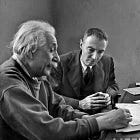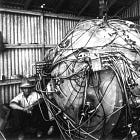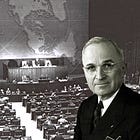When the young scientists recruited for the Manhattan Project moved into the stark buildings of Los Alamos, New Mexico, surrounded by barbed wire, they understood that they would be working on a top-secret project that could win the war. Most knew that they were there to build the world’s first atomic bomb, but didn’t know much more beyond that.
To bring everyone up to speed, physicist Robert Serber gave five lectures in early April 1943 on the scientific and engineering challenges ahead. His lecture notes, mimeographed and given to all subsequent arrivals, became knows as The Los Alamos Primer. Today, it still serves as a valuable guide to the essentials of an atomic bomb.
Serber got right to the point: “The object of the Project is to produce a practical military weapon in the form of a bomb in which the energy is released by a fast neutron chain reaction in one or more of the materials known to show nuclear fission.”
The discovery of fission was new, but the idea of the atom goes back to the early Greek thinkers. In about 400 BCE, Democritus reasoned that if you continuously divided matter, you would eventually get down to the smallest, undividable particle, which he called an atom, meaning “uncuttable.” By the beginning of the twentieth century, scientists realized the atom had an internal structure. In 1908 Ernest Rutherford discovered that atoms had a central core, or nucleus, composed of positively-charged protons, surrounded by the negatively charged electrons detected by J. J. Thompson eleven years earlier.
In 1932 James Chadwick discovered that there were particles equal in weight to the proton in the nucleus, but without an electrical charge. He dubbed them neutrons. This led to the atomic model that we are familiar with today, of an atom as a miniature planetary system, with a nucleus of hard, round balls of protons and neutrons with smaller electron balls orbiting around.
Familiar, but not quite right. Danish physicist Niels Bohr, among his many other contributions, found that a large nucleus behaved more like a water droplet. His insight led to a breakthrough discovery in 1939. German scientists Otto Hahn and Fritz Strassman, working with physicist Lise Meitner, had been bombarding uranium, the heaviest element found in nature, with neutrons and observing the new elements that seemed to form.
Uranium has an atomic number of 92, meaning it has 92 protons in its nucleus. The scientists thought that the neutrons were being absorbed by the uranium atoms, producing new, man-made elements, but chemical analysis indicated that this was not the case. When Meitner and physicist Otto Frisch applied Bohr’s water droplet model to these experimental results, they realized that under certain conditions the nucleus would stretch and could split in two, like a living cell. Frisch named the process after its biological equivalent: fission.
Three events happen during fission. The least important, it turns out, is that the uranium atom splits into two smaller atoms (usually krypton and barium). Scientists had finally realized the dream of ancient alchemists—the ability to transform one element into another. But it is the other two events that made the discovery really interesting.
The two newly created atoms weigh almost exactly what the uranium atom weighed. That “almost” is important. Some of the weight loss is attributable to neutrons flying out of the atom. These are now available for splitting other, nearby uranium nuclei. For every one neutron that splits a uranium nucleus, two more, on average, are generated. Splitting one nucleus can, under the right conditions, lead to the splitting of two additional nuclei, then four, then eight, on up. This is the chain reaction that can start from a single neutron.
The third event is the real payoff. Each fission converts a small amount of the mass of the atom into energy. The first scientists to discover fission applied Einstein’s famous formula, E = mc2, and quickly realized that even this small amount of matter (“m”) multiplied by the speed of light squared (“c2”) equals a very large amount of energy (“E”).
Energy at atomic levels is measured in electron volts. Normal explosive reactions, such as with dynamite, and indeed chemical reactions, involve the forming or breaking of bonds between the electrons of individual atoms, each releasing energies of a few electron volts. Splitting a single uranium nucleus, however, results in an energy release of almost 200 million electron volts.
Splitting all 2,580,000,000,000,000,000,000,000 (2.58 trillion trillion) uranium atoms in just one kilogram of uranium would yield an explosive force equal to ten thousand tons of dynamite. This was the frightening calculation behind the Frisch-Peierls memo and Einstein’s letter to Roosevelt. One small bomb could equal the destructive force of even the largest bomber raid.
The Right Stuff
Understanding these calculations was the easy part. There wasn’t any great “secret” to atomic energy (and there isn’t now). Physicists at the time in the United States, Great Britain, Russia, Germany, Italy, and Japan all quickly grasped the significance of nuclear fission. The hard part, and this is still true today, is producing the materials that can sustain this chain reaction.
Some concluded that the material could not be made, or at least not made in time to affect the course of the war. Others disagreed—among them the influential authors of the MAUD committee report. The crucial difference in the United States was not superior scientific expertise but the industrial capability to make the right materials. Gen. Leslie Groves used this capability to build by the end of the war the manufacturing equivalent of the American automobile industry—an entirely new industry focused on creating just one product.
To understand the challenge the United States faced then, and which other nations who want nuclear weapons face today, we have to delve a little deeper into atomic structures. Ordinary uranium cannot be used to make a bomb. Uranium, like many other elements, exists in several alternative forms, called isotopes. Each isotope has the same number of protons (and so maintains the same electric charge) but varies in the number of neutrons (and thus, in weight).
Most of the atoms in natural uranium are the isotope U-238, meaning that they each have 92 protons and 146 neutrons for a total atomic weight of 238. When an atom of U-238 absorbs a neutron, it can undergo fission, but this happens only about one-quarter of the time. Thus, it cannot sustain the fast chain reaction needed to release enormous amounts of energy.
But one of every 140 atoms in natural uranium (about 0.7 percent) is of another uranium isotope, U-235. Each U-235 nucleus has 92 protons but only 143 neutrons. This isotope will fission almost every time a neutron hits it. The challenge for scientists is to separate enough of this one part of fissile uranium from the 139 parts of non-fissile uranium to produce an amount that can sustain a chain reaction. This quantity is called a critical mass. The process of separating U-235 is called enrichment.
Almost all of the $2 billion spent on the Manhattan Project (about $34 billion in 2023 dollars) went toward building the vast industrial facilities needed to enrich uranium. The Army Corps of Engineers built huge buildings at Oak Ridge, Tennessee, to pursue two different enrichment methods. The first was gaseous diffusion. This process converts the uranium into gas, then uses the slightly different rates at which one isotope diffuses across a porous barrier to separate out the U-235. The diffusion is so slight that it requires thousands of repetitions—and hundreds of diffusion tanks. Each leg of the U-shaped diffusion plant at Oak Ridge was a half-mile long.
The other system was electromagnetic separation. Again, the uranium is converted into a gas. It is then moved through a magnetic field in a curved, vacuum tank. The heavier isotope tends to fly to the outside of the curve, allowing the lighter U-235 to be siphoned off from the inside curve. Again, this process must be repeated thousands of times to produce even small quantities of uranium rich in U-235. Most of the uranium for the bomb dropped on Hiroshima was produced in this way.
Both of these processes are forms of uranium enrichment and are still in use today. By far the most common and most economical method of enriching uranium, however, is to use large gas centrifuges. This method (considered but rejected in the Manhattan Project) pipes uranium gas into large vacuum tanks; rotors then spin it at supersonic speeds. The heavier isotope tends to fly to the outside wall of the tank, allowing the lighter U-235 to be siphoned off from the inside. As with all other methods, thousands of cycles are needed to enrich the uranium. Uranium enriched to 3–5 percent U-235 is used to make fuel rods for modern nuclear power reactors. The same facilities can also enrich uranium to the 70–90 percent levels of U-235 needed for weapons. (This inherent “dual-use” capability is one of the key problems in controlling the spread of nuclear weapons and is explored further in chapters 2, 4, and 6.)
The Plutonium Path
There is a second element that can sustain a fast chain reaction: plutonium. This element is not found in nature and was still brand-new at the time of the Manhattan Project. In 1940, scientists at Berkeley discovered that after absorbing an additional neutron, some of the U-238 atoms transformed into a new element with 93 protons and an atomic weight of 239. (The transformation process is called beta-decay, where a neutron in the nucleus changes to a proton and emits an electron.)
Uranium was named after the planet, Uranus. Since this new element was “beyond” uranium, they named it neptunium after the next planet in the solar system, Neptune. Neptunium is not a stable element. Some of it decays rapidly into a new element with 94 protons. Berkeley scientists Glenn Seaborg and Emilio Segré succeeded in separating this element in 1941, calling it plutonium, after the next planet in line, Pluto.
Plutonium-239 is fissile. In fact, it takes less plutonium to sustain a chain reaction than uranium. The Manhattan Project thus undertook two paths to the bomb, both of which are still the only methods pursued today.
Complementing the uranium enrichment plants at Oak Ridge, the Project built a small reactor at the site and used it to produce the first few grams of plutonium in 1944. The world’s first three large-scale nuclear reactors were constructed that year in just five months in Hanford, Washington. There, rods of uranium were bombarded with slow neutrons, changing some of the uranium into plutonium. This process occurs in every nuclear reactor, but some reactors, such as the ones at Hanford, can be designed to maximize this conversion process.
The reactor rods must then be chemically processed to separate the newly produced plutonium from the remaining uranium and other highly radioactive elements generated in the fission process. This reprocessing typically involves a series of baths in nitric acid and other solvents and must be done behind lead shielding with heavy machinery.
The first of the Hanford reactors went operational in September 1944 and produced the first irradiated slugs (reactor rods that had been bombarded with neutrons) on Christmas Day of that year. After cooling and reprocessing, the first Hanford plutonium arrived in Los Alamos on February 2, 1945. The lab had gotten its first 200 grams of U-235 from Oak Ridge a year earlier and it now seemed that enough fissile material could be manufactured for at least one bomb by August 1945
The Manhattan Project engineers and scientists had conquered the hardest part of the process—producing the material. But that does not mean that making the rest of the bomb is easy.
To be continued…….
This is the second of my five-part series on the science, history and politics of the beginning of the nuclear age, based on my book, Bomb Scare: The History and Future of Nuclear Weapons (Columbia University Press, 2008). I hope you will see the Oppenheimer film and read the other chapters in this story:













Love your writing!!
Great series of articles...very detailed and informative
As a minor technical point, absorbing neutrons does not change one element into another. It creates an isotope. (paragraph 7).